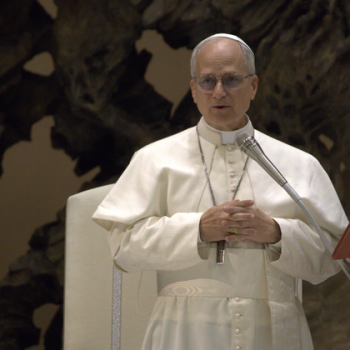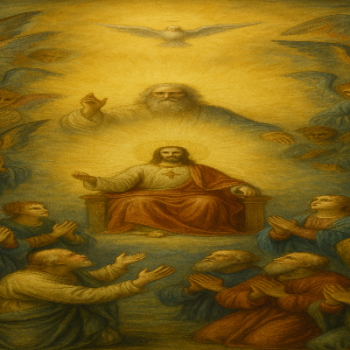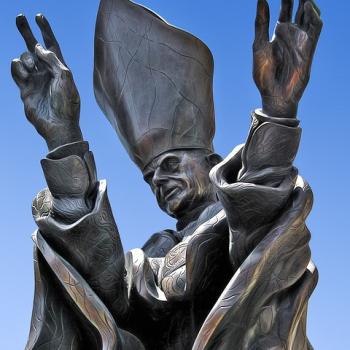
The intellectual history of Catholic theology is vibrant and surprisingly varied. Arguably, the two most significant contributors to that rich and varied theology are Saints Augustine and Aquinas.
To be certain, there is much that Augustine and Aquinas agree upon. However, there are points of variance, and in the essay, I want to examine one such area of disagreement: Christology.
Perhaps disagreement is too strong a word. Maybe it is better to state that there are different areas of emphasis that these two saints take when writing on Christology.
Before examining the individual Christologies of Augustine and Aquinas, it is beneficial to discuss theology and Christology in a very general way.
An Overview Of Catholic Christology
It will come as no surprise that Augustine and Aquinas have contributed immensely to the opus that is Catholic theology. For the purpose of this paper, I will utilize Saint Augustine’s definition of theology. That is, theology is “reasoning or discourse about the Divine.” (Augustine, Saint. City of God. Penguin UK, 2003.)
Under the umbrella of theology, Christology is the discipline that concerns itself with the person and doctrines of Jesus Christ. Within Christology, five topics predominate. They are the hypostatic union (the two natures of Christ); the Incarnation (God becoming human); the Resurrection and its significance on salvation history; the various titles attributed to Jesus such as “Christ,” “Son of God,” “Lord,” and “Messiah,” and their theological significance; and finally, soteriology which studies how the work of Christ made salvation possible.
Having provided a brief and admittedly incomplete summary of Catholic Christology, I turn to the individual and specific contributions to Christology that Augustine and Aquinas have provided.
Augustine’s Christology
It is all but impossible to understand or discuss Augustine without referencing his book, Confessions. In Confessions, Augustine’s Christology is shown to be predicated on man’s relationship with Christ. For Augustine, Christ is the touchstone in the spiritual journey and the mediator between humanity and God.
This aspect of Augustine’s Christology saw Christ as the essential mediator between fallen humanity and the transcendent God. Furthermore, Augustine saw Christ as the way humanity could attain wisdom and happiness.
Saint Augustine held firmly to the belief in the hypostatic union or the position that Christ was fully God and fully human. This fundamental belief manifested in his opposition to Manichaeism, which held that Christ possessed a divine nature only while appearing human.
This aspect of Augustine’s Christology significantly influenced the Council of Chalcedon (451 A.D). At Chalcedon, the Catholic Church formalized the doctrine of the hypostatic union, declaring Christ to be of two natures in one person.
Understandably, the Incarnation is central to Augustine’s Christology. In particular, he emphasized Christ’s humanity as critical to the role of the redeemer. This belief was balanced by Augustine’s view that Christology is inseparable from understanding the Trinity.
Aquinas On Christology
Thomas Aquinas’s influence on Catholic theology is, I think, unparalleled. His opus, the Summa Theologica, is foundational and immensely important to the teachings and beliefs of the Catholic Church.
Aquinas’s Christology is predicated on the belief that the Word of God (Logos) assumed a complete human nature (body and soul, mind and will) in the womb of the Virgin Mary. Christ is the union of two natures: one divine and one human.
Like Augustine, Aquinas realized that Christ’s human nature was essential in effecting the salvation of the human race. Saint Thomas viewed Christ’s humanity as instrumental in the redemption of the world, with every grace given through the humanity of Christ.
Moreover, for Thomas, Christ is seen as God’s perfect image, through whom humanity is restored and perfected.
Despite this, Aquinas’s Christology is intrinsically Trinitarian. That is, it must be understood within the context of the Trinity (Father, Son, and Holy Spirit). For example, Aquinas believed that the Son and the Holy Spirit are sent into the world for the dispensation of grace, a claim that must be grounded in Trinitarian terms. (See Aquinas, Saint Thomas. The “Summa Theologica” of St. Thomas Aquinas. 1917).
Competing Christologies
While the above is a brief synopsis of the Christologies of these two saints, it is clear that they shared many of the same theological positions. However, there are several areas where their Christologies diverge.
One source of the differences between Augustine and Aquinas is their teaching and writing styles. Augustine’s style is pastoral, while Aquinas’s style is systematic. While it can be claimed that this difference is one of semantics, it does affect the emphasis and purpose of their work.
Examples of this difference can be found in Augustine’s writings, which strongly emphasize inner experience and the subjective encounter with Christ. Conversely, Aquinas’s approach is systematic and objective.
Perhaps the most significant difference is the philosophical frameworks each utilized to develop their Christologies. Saint Augustine was affected by the teachings of Plato. Aristotle provided Aquinas with the foundation for his metaphysics.
Augustine’s platonic leanings colored his understanding of Christ’s divine nature and the relationship between the divine and the human. This can be seen in Augustine’s use of platonic ideas to explain the nature of God and how Christ, as the word of God, interacts with the created world.
An example can be seen in Augustine’s modification of Plato’s “forms.” For Augustine, the “forms” exist in God’s mind and are the source of the order and purpose in the created world.
Not surprisingly, Aquinas integrates Aristotelian philosophy into his theological system, leading to a rational approach to Christology. Moreover, Aquinas seeks a precise and logical explanation of the Incarnation and the relationship between Christ’s divine and human natures.
Augustine’s Christology is deeply interwoven with his understanding of original sin and the need for divine grace for salvation. As such, Augustine emphasizes humanity’s fallen state and the absolute dependence on God’s grace for redemption. This is manifested in Christ.
While affirming Christ’s divinity, Aquinas gives greater attention to the details of Christ’s humanity. Aquinas seeks to create an exact and detailed understanding of the hypostatic union.
Conclusion
It goes without saying that both Augustine and Aquinas contributed significantly to the development of Catholic Christology. Augustine’s emphasis on grace and inner experience laid the groundwork for later theological reflection. Thomas Aquinas’s systematic approach provided a more refined and comprehensive understanding of the person and work of Christ.
More specifically, while it is true that Augustine and Aquinas centered their Christologies on the divinity and humanity of Jesus, they have different points of emphasis.
Augustine emphasized the completeness of both natures, with Christ’s human soul as the point of departure. At the same time, Aquinas focused on the incarnational nature of Christ and the importance of the hypostatic union for human salvation.
















